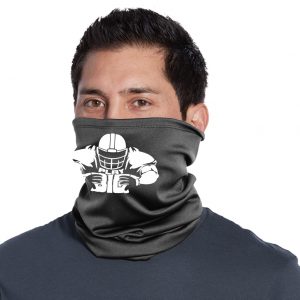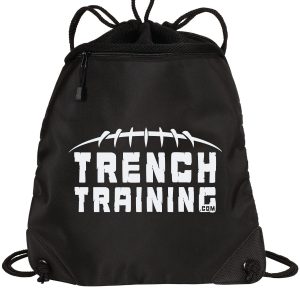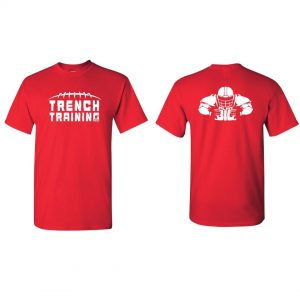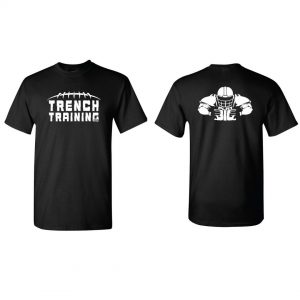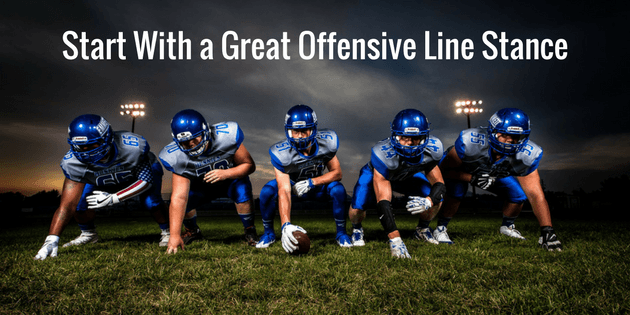
by Steve Stark | Jan 31, 2017 | Blog, player development, training
In the o-line everything we do starts with our offensive line stance.
Coach Derby always says, “Playing offensive line is not a natural thing.”
Running, throwing, catching and kicking are all natural actions for our bodies.
Great offensive linemen start with a great offensive line stance.
Getting in a good three point stance is not a natural action.
Firing off the ball, staying low, and blocking are not natural actions.
All of these actions must start with a great stance that we are comfortable getting in and out of.
So how do we make an unnatural action feel natural?
Repetition. repetition, repetition.
Just like anything else we learn to do athletically, we learn it through repetition and muscle memory.
5 Key Elements of a Great Offensive Line Stance
Base
Every good football stance, regardless of position, requires a solid base.
For offensive lineman finding a comfortable, powerful and effective base can be challenging.
Many young players, especially bigger kids, often have a really wide base in their stance.
They do this because it’s easier and more comfortable.
The problem when players get much wider than their shoulders is that they lose mobility.
We want our offensive linemen to be able to move in all directions out of the same stance.
Feet
Another common issue for young offensive linemen is getting them off their toes in their stance.
This is also difficult because it’s easier and more comfortable to be on your toes than to keep your whole foot in the ground.
One of things we talk to our players about is keeping the whole foot in the ground in our stance and when we block.
Doing this helps us to take full advantage of our power base activating muscles up through our quads, hips and glutes.
Having our whole foot in the ground in our stance also helps us to maintain our balance and allows us quick take-off in any direction.
Light Hand
How many times, as a defensive player, have you seen offensive linemen with white knuckles.
Dead giveaway telling which direction that player is headed, right?
We want to be just as explosive, in any direction, without tipping off where we are going.
We can do this if we rely on our power base and feet to provide balance and keep minimal weight on our down hand.
Don’t give away what you’re doing with your offensive line stance.
Flat Back & Head Up
If you are looking at ground as a blocker then that’s where you end up.
And you can’t block anyone lying on the ground.
You also need to see where you are going from your offensive line stance.
Keep your head up and keep your back flat.
Young players have one of two problems.
They either squat like frogs or have no knee bend with their butt up in the air.
Offensive linemen need to find that happy medium, get that flat back and be coiled to strike.
Power producing position
One of my college coaches favorite lines, “You need a “Z” in the knee!”
Linemen need to be knee-benders not waist-benders.
The easiest way that I’ve been able to explain this to kids is to tell them to get their thighs parallel to the ground.
Offensive linemen need to be able to generate force off the line in any direction.
To do that you need to have good knee bend.
The thing you have to be careful of is not to get frog squatters.
You know… that guy who’s butt is a foot below his knees.
Balance is the key to an all-way go from your stance and you need that knee bend to have balance.
Stance has to be one of the pillars of building a great offensive lineman.
Too many coaches overlook the importance of spending time on a players stance.
Without the proper offensive line stance players will not reach their potential.
Spend time on your stance.
Get comfortable in it and make it second nature.
If you you found value with today’s post please like, comment and share.
Play Big!

Coach Steve
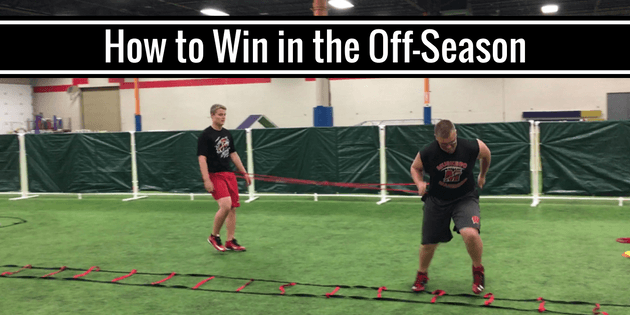
by Steve Stark | Nov 15, 2016 | player development, training
We often get the question, “What should my kid be doing during the off-season?”
A football season takes a great deal from a player both physically and emotionally.
Fo young players and old, it’s important to decompress a little.
Taking a couple weeks off is actually great for your body.
All the bumps and bruises get healed up and we get back to normal physically.
The emotional drain on a player also demands some recovery time.
As a 3-sport athlete in high school I was always pretty worthless the first week of basketball.
Only time and rest can give you the recovery you need.
So what do we do once our healing is done?
Here are some tips to have the best off-season possible.
4 Ways to Have a Great Off-Season
Play other sports.
Take advantage of every chance you get to compete in athletics.
The experience of competing against other drives your development as an athlete.
There are things you learn in competition that cannot be learned any other way.
Sportsmanship, effort, game intelligence, and the ability to deal with adversity are just a few.
There’s also a huge benefit physically to playing other sports.
As a football player, basketball had a significant impact on improving my footwork and overall athleticism.
Every sport requires a different set of athletic skills and ability.
When you take advantage of this physical development it will significantly improve your athleticism.
Check out our previous article on the Advantages of Being a Multi-Sport Athlete.
Drill the skills.
Every position on the football field has a set of skills that need to worked.
This is the biggest deficiency that we see in the development of linemen.
Just because we don’t throw, catch or kick the football does not mean we cannot develop skills for our position.
Stance, take-off, punch, footwork, pass sets and pass rush moves are all skills that should be repped in the off-season.
Improve your craft. Drill the skills!
Stay focused on school.
As a high school coach for many years, I saw many kids fall off in school when the football season ended.
What many of them didn’t realize was that there spring grades effected their eligibility for the following season.
The majority of high schools across the country begin their season prior to the start of school.
In Wisconsin, our teams play two games before the start of the school year.
Very few athletes go on to play college sports.
According to NCAA.org statistics from the 2014-2015 season, 2.6% of high school football players moved on to play in NCAA Division I programs.
Of those players in NCAA Division I football only 1.6% went on to the NFL.
While we love to encourage kids to dream big, it should never be at the expense of their education.
Stay focused on school and be a great student and citizen.
Create a plan.
Give some thought to what you want to accomplish during your off-season.
Think about who you wan to be when you start training camp next fall.
Envision it.
What do you weigh?
How strong are you?
How fast are you?
What does your footwork, punch, stance, and take-off look like?
Really give it some thought and then write it down.
I know… you think that sounds weird and crazy, right?
WRONG!
You have the power to become the best version of yourself.
If you can conceive it, you can achieve.
Writing it down makes it real.
It holds you accountable to yourself.
Give it a try and let us know how that works for you.
Remember, it’s okay to dream big.
In fact… it’s a must if you want to PLAY BIG!
If you you found value with today’s post please like, comment and share.
Play Big!

Coach Steve
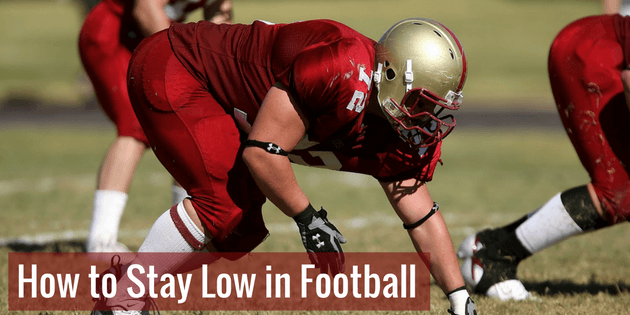
by Steve Stark | Nov 1, 2016 | player development, training
Learning how to stay low in football is the key to success in the line.
“LOW MAN WINS!”
Every football player has heard a coach say this.
So why is that low man wins in football?
It’s all about leverage.
Players who can stay low will play with leverage.
Leverage allows players to take advantage of their lower body strength.
We often talk about teaching kids to be knee benders and not waist benders.
Waist benders have no power and therefore no leverage.
This is why we see smaller players sometimes dominate larger opponents because they play low and maintain leverage.
Let’s look at some things we can teach how to stay low in football.
How to Stay Low in Football
Start with a good stance.
Whether on offense or defense, we look for good bend in the knees and a stable, balanced stance.
Offensive linemen need to get there but down and play with a flat back.
We also want as much of their feet in the ground as possible and a minimal amount of weight on their down hand.
This allows the offensive lineman to release in any direction.
For defensive linemen, we look for more weight on their hand and their butt up a little.
This is a bit more of track stance to get off the ball and disrupt.
Of course, different offenses and defenses may want different approaches but this is a general rule.
Either way pad level coming off the ball has to be a huge factor in stance setup.
Build core strength.
Athleticism is based in the core.
Our definition of the core includes the hips up to just below the chest wrapping around the entire the body.
It’s not just abs!
The core includes not only the abdomen but the hips, obliques and lower back.
It also includes all the small stabilizing muscles around the spine.
Everyting in the core is not only essential for athletic ability but also injury prevention.
In order to play with low pad level the core needs to be very strong and stable.
Continually work on hip flexibility.
We discussed this recently but it cannot be emphasized enough.
While we consider hips to be a part of the core it requires extra attention.
Without the proper hip hinge and flexibility we cannot play low.
The hips are what allow us to bend properly at the knee while keeping a flat stable back.
This helps us to use our powerbase for leverage with form that keeps us healthy.
Repetition, Repetition, Repetition.
The way to play low is to train low and practice low.
Repetition is the only way we condition our bodies to play with good pad level.
How we train and maintain our flexibility every day of the off-season will have an effect on our pad level during the season.
Spending the time on stance, core strength and hip flexibility will determine our ability to play low.
If you you found value with today’s post please like, comment and share.
Play Big!

Coach Steve
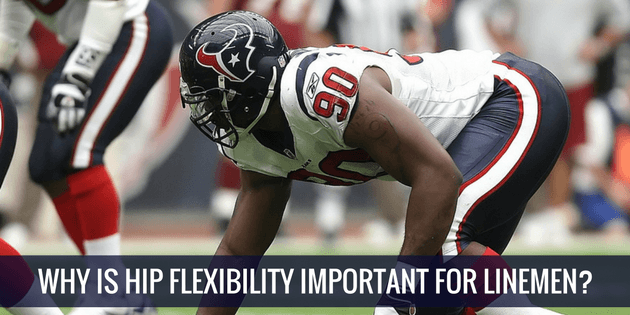
by Steve Stark | Oct 18, 2016 | player development, training
Hip flexibility is the number one thing we at Trench Training hear about from college coaches.
How are their hips?
Do they play with their pads out?
Can they change direction?
These are some of the most common questions college coaches are asking when they watch video of recruits.
Size, strength and power all factor in to be an elite football player.
But hip flexibility is one of the key components coaches look for.
So why is hip flexibility important?
3 Benefits of Good Hip Flexibility
1. Injury prevention.
A lack of flexibility in the hips can have an impact on lower back health.
This is especially prevalent in the weight room.
Without the proper range of motion, an athlete’s form is compromised and the risk of injury increases.
We need our athletes to stay healthy and flexibility is a key component to preventing injury.
2. Improved agility and balance.
You might think agility is not a word often used with linemen.
Maybe defensive linemen but not offensive linemen, right?
Wrong.
Speed may not be a prerequisite to play in the line but agility is.
Lateral movement and quickness are a huge part of being an elite linemen.
Footwork and body position are essential for both blocking and defeating a block.
Agility and balance are also how linemen create leverage and gives them the ability to “play low”.
Playing low allows us to utilize the strength in our legs and glutes giving us a powerful base.
3. Increased explosiveness.
You have probably heard the saying, “low man wins”.
Again, playing low is going to give us a the ability to coil and become explosive off the line.
If a player is more explosive off the ball then their opponent they will have a distinct advantage.
Utilizing leverage and explosiveness, a player can compete with opponents that are bigger and stronger they are.
Hip flexibility is essential to gaining explosiveness.
What is the hip hinge?
Here’s the best definition I’ve found for the hip hinge and it’s from BreakingMuscle.com.
“A hip hinge is movement (flexion and extension) through the hip joint, keeping a neutral spine and the knees slightly flexed.”
A great way to test the hip hinge is to do the dowel hip hinge test.
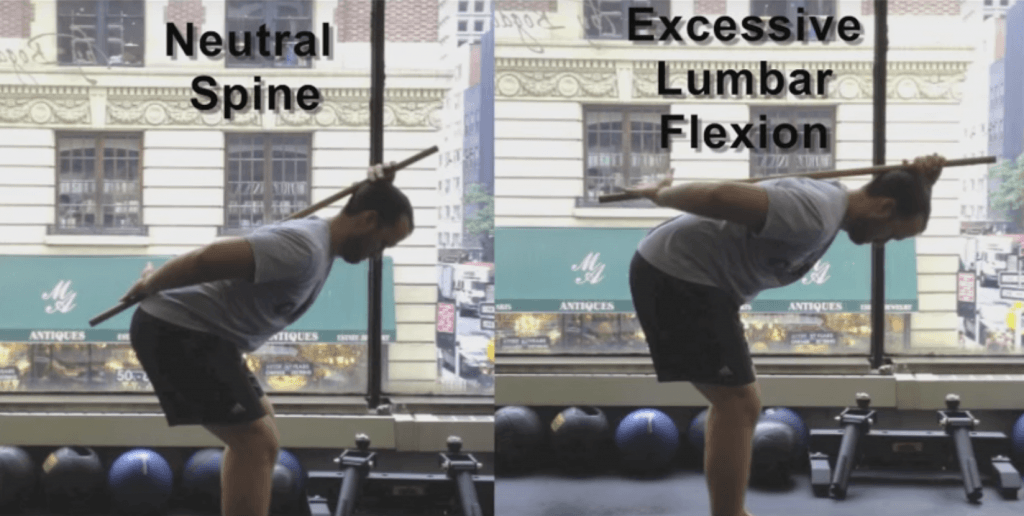
Hip Hinge Dowel Test from Aaron Swanson via Youtube
In the image above, on the left you can see what it means to keep a neutral spine.
This is opposed by lumbar flexion on the right which is what you get when your hips are too tight.
Many players lack sufficient flexibility in hip flexors and adductors.
Improving this hip flexibility lays the foundation for improved athleticism and is the key to reaching elite levels.
If you you found value with today’s post please like, comment and share.
Play Big!

Coach Steve
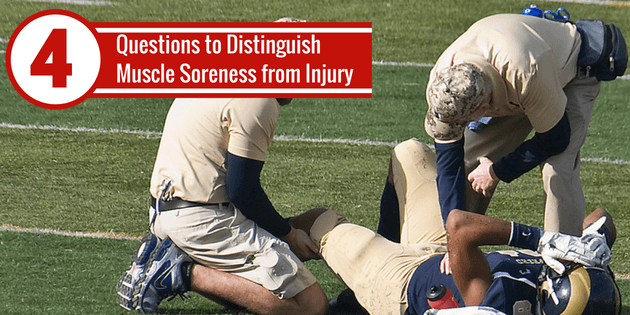
by Steve Stark | Aug 8, 2016 | training
The start of football practice brings so many exciting things.
Getting your helmet & pads, putting on your practice jersey for the first time, seeing all your friends that you haven’t seen much over the summer, meeting new coaches…
There’s also the not so exciting things like gassers, cross fields, sprint ladders, sit-ups, pushups, and the dreaded muscle soreness.
Sometimes it can be difficult to tell if you child has muscle soreness or if they have an injury.
In today’s post, we are going to discuss the difference between being sore and being injured/hurt.
[video_player type=”embed” width=”560″ height=”315″ align=”center” margin_top=”0″ margin_bottom=”20″] [/video_player]
[/video_player]
Have you ever heard someone say that they are getting in “football shape”?
What does it mean to be in football shape?
No matter how fit a player is heading into a football season it’s not the same as football practice and games.
A football player uses muscles every day in practice in a way that they are not simulating in training.
That alone will create a lot of muscle soreness in that first week of practice.
Just about the time a player starts to feel better… we add pads.
Wearing pads and participating in contact drills adds a whole other level of soreness.
This is VERY normal.
What is difficult to tell, at times, is the difference between being sore and being hurt or injured.
Let’s be clear we are NOT doctors and we didn’t stay at a Holiday Inn last night, but we have a little experience with soreness and injury.
Here are 4 questions to help you determine what’s happening with your athlete.
4 Questions to Distinguish Muscle Soreness from Pain
How does your athlete describe the pain?
Is it a dull ache when they move?
More times than not this is muscle soreness.
If the pain is sharp or acute then that could be the sign of an injury.
Body language tells a lot.
When you first put the pads on for fall football camp it feels like you got hit by a dump truck.
This is completely normal.
Sharp or acute pain is not normal and that’s the number one thing you want to listen for from your athlete.
Where on the body is the pain?
Is the pain is in the joint or in the muscle?
If the pain is in the joint then you should definitely be concerned that there may be some form of injury.
Soreness will mostly occur in the muscle however muscles can certainly sustain injury as well.
Joint pain is often a sign of a strain or a tear in a ligament.
Be sure to get that looked at immediately.
How long does the pain persist?
Muscle soreness doesn’t generally last more than 2-3 days.
That said… your athlete will likely be sore after the first day of practice and then again after the first day of practice in pads.
Those are a given every year.here are just days when your athlete does something new
There are also just days when your athlete does something new that have not done before.
Any time you use muscles in a different way you are like to get sore.
Scrimmages and games are also going to cause some soreness.
Because games move at a different speed, athletes push their muscles past normal limits.
Some of the worst days of muscle pain for me were the day after games.
I remember those days in some cases more than playing in the games.
All of these times when an athlete gets sore lasts only a day or two.
A good guideline to consider for your athlete is if the pain that persists for more than a week, then get it checked out by a doctor.
Is there pain at rest? Without moving.
With muscle soreness, there usually isn’t a lot of pain when you’re not moving.
Muscle soreness gets better after you are up and moving and warm the muscles up.
If you are getting pain without moving then you likely have an injury.
That is a sign of inflammation.
Inflammation is the body’s response to injury.
Here’s a good explanation from SportsInjuryClinic.net…
[feature_box style=”16″ title=”Inflammation” alignment=”center”]
When the body is injured a sequence of events is initiated that leads to the eventual repair of the injury site. The first stage in this process is inflammation which is followed by tissue healing and repair.
[/feature_box]
Check out the full article at SportsInjuryClinic.net.
Most often, you’ll notice swelling with a muscle strain or joint injury.
However, an athlete can have inflammation without obvious swelling.
Again, if your athlete is having pain without moving, get it checked out.
Muscle Soreness Recovery Tips
1. Get more sleep.
Sleep is when the body makes it’s repairs.
The body takes protein and repairs muscles.
Depriving the body of sleep will decrease it’s repair time.
Get sleep!
2. Stay hydrated.
Water is an essential ingredient to repairing the body.
It lubricates the joints and helps with blood flow.
Not only does hydration help during activity it’s ultra-important for repair.
Therefore, be sure your athlete is drinking water thorughout the day and not just at practice.
3. Eat more protein.
Protein is another essential ingredient for repairing the body.
Not only is protein needed to properly fuel the body, it’s a must for repair.
Athletes require more protein because they are constantly using it for fuel and repair.
Start your day with high protein meal and try to get a light protein snack in before going to sleep.
4. Drink chocolate milk.
Chocolate milk is a great post-workout snack.
The protein combined with the carbohydrates in chocolate milk make it a perfect way to get your body’s repairs kickstarted.
5. Foam roller.
Using a foam roller on a daily basis can have a huge impact on muscle soreness.
Most soreness from exercise is related to knotting in the fascia.
The fascia is connective tissue that runs throughout the body over the muscles.
Knots (also called hotspots) form in the fascia with normal damage from exercise.
Using a semi-rigid foam roller to knead out the hotspots will do wonders to alleviate muscle soreness.
6. Cold bath.
Ice baths, while not pleasant, have been shown to be very effective.
A full-body plunge after a heavy workout can help reduce muscle soreness and inflammation for up to 24 hours.
There are a lot of other home remedies out there for soreness.
Every athlete is different and has different needs when it comes to recovery.
Be sure to listen to your athlete and find out what they need.
Maintaining a healthy body is the key to success in any sport.
I hope you found some value with today’s post.
If you did please like, comment and share.
Play Big!

Coach Steve
Photo credits:
Ron Cogswell – altered
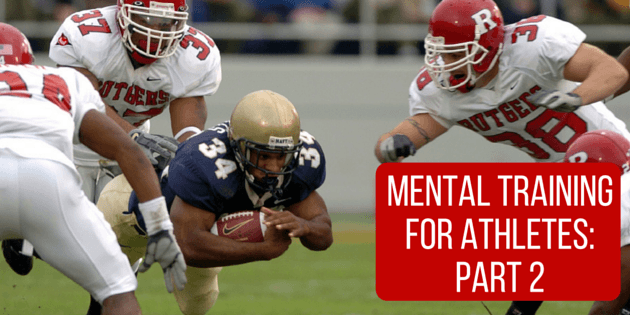
by Steve Stark | Apr 9, 2016 | Blog, training
The second part of Mental training is all about performance.
The information I am focusing on in this article is based on research by Dr. Jack Lesyk’s and his article on Sportpsych.org.
Dr. Jack Lesyk, Ph.D. Uses a performance chart that makes a lot of sense to me in how you become a high performing athlete.
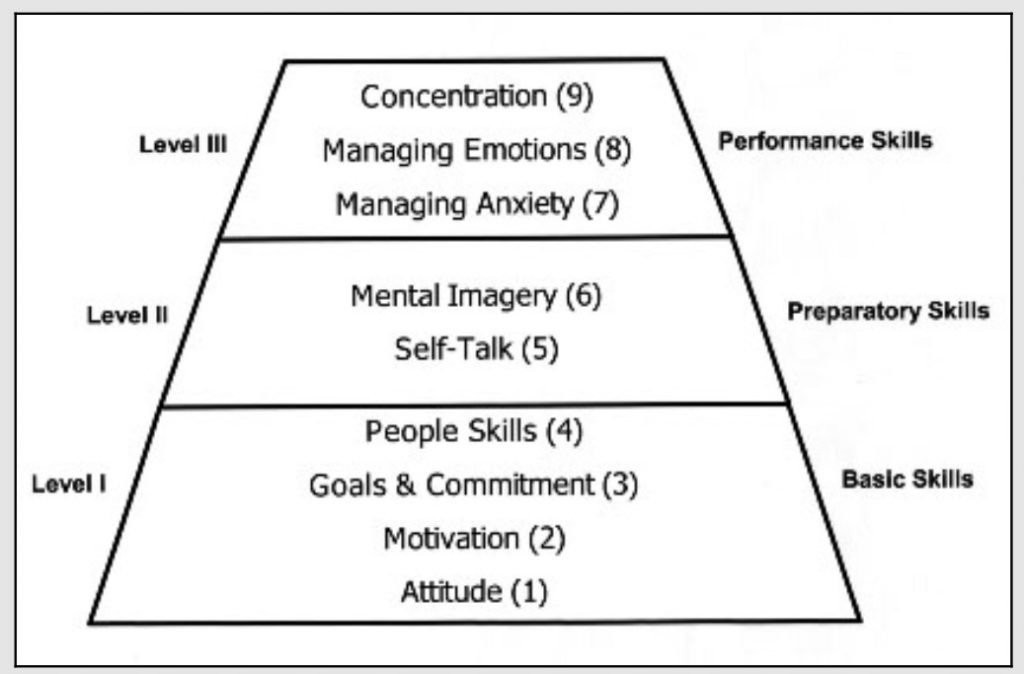
His pyramid describes the levels that an athlete must move through to become a high functioning athlete.
I agree that there are short and long term phases in athletics.
Many of the athletes struggle with their talent because their emotions are not able to handle the competition.
It has nothing to do with their skill or talent but all to do with handling their emotions. This is level 3.
Mental Training for Athletes: The Performance Pyramid
Although each of the nine skills is important, its primary importance will occur during one of three phases: long-term development, immediate preparation for performance, and during performance itself.
Level I
These mental skills constitute a broad base for attaining long-term goals, learning, and sustaining daily practice.
They are needed on a day-by-day basis for long periods of time, often months and years.
Level II
These skills are used immediately before performance to prepare for performance.
They maybe used just before competition begins, or immediately before a specific performance action, such as a golf shot or a free throw in basketball.
Level III
These skills are used during actual performance behavior.
Spending time on These 9 Mental skills will help you attain the level III in athletics.
Detailed Descriptions of the Nine Mental Skills
1. Attitude
Successful athletes:
- Realize that attitude is a choice.
- Choose an attitude that is predominately positive.
- View their sport as an opportunity to compete against themselves and learn from their successes and failures.
- Pursue excellence, not perfection, and realize that they, as well as their coaches, teammates, officials, and others are not perfect.
- Maintain balance and perspective between their sport and the rest of their lives.
- Respect their sport, other participants, coaches, officials, and themselves.
Choice is the key word . Many athletes don’t realize that they can choose how they think. This is something that everyone can do! Viewing life as an opportunity as opposed to a right. We are not owed anything. When we realize this it makes a huge difference in our level of anxiety and stress. The less stressed and anxious we are the better we perform! Respecting the game, the coaches, other players, and yes, the parents that haul you around and buy your gear, is so important in helping you move towards your goals of being great!!
2. Motivation
Successful athletes:
- Are aware of the rewards and benefits that they expect to experience through their sports participation.
- Are able to persist through difficult tasks and difficult times, even when these rewards and benefits are not immediately forthcoming.
- Realize that many of the benefits come from their participation, not the outcome.
Consequences and rewards are a great motivational tool to use on yourself. Coaches and parents will use their own methods of rewards and consequences but it is important for you to come up with your own appropriate consequences and rewards system.
3. Goals and Commitment
Successful athletes:
- Set long-term and short-term goals that are realistic, measurable, and time-oriented.
- Are aware of their current performance levels and are able to develop specific, detailed plans for attaining their goals.
- Are highly committed to their goals and to carrying out the daily demands of their training programs.
I talked in depth about this in the previous article. Goals are very important and paying attention to progress is a big part of this.
4. People Skills
Successful athletes:
- Realize that they are part of a larger system that includes their families, friends, teammates, coaches, and others.
- When appropriate, communicate their thoughts, feelings, and needs to these people and listen to them as well.
- Have learned effective skills for dealing with conflict, difficult opponents, and other people when they are negative or oppositional.
Sometimes athletes are not real social. This does not mean that they do not have people skills. They may have very good skills but choose to use them sparingly. There is nothing wrong with this type of athlete and I have seen many who go on to play at a high level. The key is for them to understand what is going on around them. They can’t allow others to affect their emotions. Learning to deal with conflict, loss and adversity is key to helping an athlete perform at his or her best.
5. Self-Talk
Successful athletes:
- Maintain their self-confidence during difficult times with realistic, positive self-talk.
- Talk to themselves the way they would talk to their own best friend
- Use self-talk to regulate thoughts, feelings and behaviors during competition.
Another skill that I mentioned in previous article that I feel is very important as well.
6. Mental Imagery
Successful athletes:
- Prepare themselves for competition by imagining themselves performing well in competition.
- Create and use mental images that are detailed, specific, and realistic.
- Use imagery during competition to prepare for action and recover from errors and poor performances.
7. Dealing Effectively with Anxiety
Successful athletes:
- Accept anxiety as part of sport.
- Realize that some degree of anxiety can help them perform well.
- Know how to reduce anxiety when it becomes too strong, without losing their intensity.
I think this is one of the most important skills and it is overlooked by many coaches, parents and athletes. Fear is another name for anxiety. Fear can cripple an athlete. It can keep an athlete from being able to perform or even function. This skill is VERY Important to look at because there is so much to learn about what and where fear comes from. Fear also is something that you can choose to overcome by working on it. I would suggest, to any young athlete, that they spend a lot of time learning what fear really is and how to overcome it.
8. Dealing Effectively with Emotions
Successful athletes:
- Accept strong emotions such as excitement, anger, and disappointment as part of the sport experience.
- Are able to use these emotions to improve, rather than interfere with high level performance
This is often a misunderstood skill and also one that does not typically get talked about by coaches and athletes. I believe emotions are not talked about because many athletes have fear that it will make them look weak. The truth is that this skill will make them strong beyond their understanding.
9. Concentration
Successful athletes:
- Know what they must pay attention to during each game or sport situation.
- Have learned how to maintain focus and resist distractions, whether they come from the environment or from within themselves.
- Are able to regain their focus when concentration is lost during competition.
- Have learned how to play in the “here-and-now”, without regard to either past or anticipated future events.
Please feel free to message us if you have questions or require more information about any of our post topics.
We want to help you and your athlete become better at both the physical and mental aspects of sport.
At Trench Training we also have sports life coaches available for you to work with if you are looking for some extra help.
Play Big!

Coach Glenn

